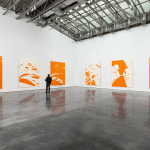
Contributed by Sharon Butler / Jack Whitten (b. 1939, Alabama) makes paintings in which paint application, embedded materials, and evocative titles embody narrative—the story of the artist’s life and his times. While I was in Minneapolis a few weeks ago, I was delighted to see the excellent retrospective of his work, organized by curator Kathryn Kanjo and first presented at the Museum of Contemporary Art San Diego last year. Installed at the Walker Art Center, the exhibition features 60 paintings and several works on paper that span five decades—from the 1960s through last year. Whitten is an inventor who revels in finding new ways to apply and manipulate paint, or, as he says, to “make paintings,” rather than “paint paintings.” Here are excerpts from two 2013 interviews in which he talks about the content and the process:
From a 2013 interview with Jessica Dawson in Art in America:
Jessica Dawson: You’ve got a painting in this show called Sandbox: For The Children Of Sandy Hook Elementary School [image at top]. It has a sweet, candy-store palette, and the acrylic molds embedded in its surface have a confectionary quality. Without reading the title, one wouldn’t know its inspiration. How do you see abstraction conveying meaning?
Jack Whitten: I maintain that abstraction is a symbol. It’s very much like holding a camera. I can direct it toward any symbol that I choose. As a painter, I have to locate that symbol in the paint, as opposed to giving an illustrated narrative. The narrative content and the figure are still in there—they’re built into the paint.
From a 2013 interview with Scott Indrisek at Modern Painters:
Scott Indrisek: Can we talk a bit about your rather unique technical process?
Jack Whitten: I make these strips of acrylic beforehand, all in different shapes. And then when I put the strips into the wet field of paint, they relax. It’s very conceptual. Everything comes together with the last step. This is not an overlay, that’s an inlay; it’s inlaid into a field of wet acrylic, and when that happens, you get a strange spatial juxtaposition. For painting, that’s a new space. I first saw a glimpse of that space in the ’70s, and I’ve been chasing it ever since. But now I’ve chased it up to a point where I can force it into a corner.
SI: Are you ever actually applying a brush to the canvas?
JW: Not so much. Sometimes, if I’m looking for a thin glaze, I might resort to some types of brushes. But to actually sit down and paint with a brush, no. I cut paint, I laminate paint, I grind paint, I freeze paint, I boil paint. I just gave a talk at Yale University and some kids were asking about the process, and I said, “Well, it’s like Chinese cooking.” You’ve got to select everything, find the best quality you can, wash it, clean it, cut it to the desired amounts, and you have all these component parts laid out to do a stir-fry. And then there is step one, step two, step three, right? And at the last moment, all these ingredients come together and the whole thing takes place in four minutes at the most.
SI: And what are the other 3-D forms that are inlaid into the paint?
JW: They come from all over. They are made from molds. One is from my orange juice bottle—Simply Orange. My wife and I went to the supermarket and bought a whole shopping cart full of it—$150 worth of orange juice—when all I was after was the bottles. The computer mouse died yesterday. We had to go to Staples to get a new mouse, and the container it came in—that’s a mold. I bought a lot of clams and took the shells and used them as molds. I call this stuff ready-now. Duchamp called his found objects readymades; I make these and I call them ready-nows. All of these plastics are different. I have to experiment to find a release that will allow me, once the acrylic is set, to be able to pull it out of the mold. My dealer in Antwerp wears a hearing aid. The last time I was in Antwerp, his wife had saved all the containers for his hearing aids and gave them to me. So I brought them back to New York and got a very good painting out of it, which of course I gave to her. The cooking industry is making a lot of nonstick products, and they’re fantastic.


A little background (via the press release):
Born in Bessemer, Alabama, in 1939, Whitten was an active participant in the civil rights movement before moving to New York City in the early 1960s, where he enrolled at Cooper Union and discovered his own experimental language of abstraction. Across the decades, he has continually been an artist of his moment due precisely to his respect for the past and commitment to the present. Whitten’s poetic and physically compelling compositions reinvent the medium of painting time and again—from his series of small “ghost” paintings of the 1960s, his smeared test slabs and dragged canvases of the 1970s, and his collaged acrylic “skins” of the 1980s to his more recent tessellated constructions of paint tiles. This traveling retrospective of some 60 canvases from the 1960s to the present is the first exhibition to span the full breadth of the artist’s work in depth.
“Jack Whitten: Five Decades of Painting,” curated by Kathryn Kanjo. Coordinated at the Walker by Eric Crosby. Walker Art Center, Minneapolis, MN. Through January 24, 2016.
Related posts:
- Quote of the Day: Jack Whitten
- Jack Whitten and Robert Storr in conversation
- Rejecting the New: Abstract painting in the 1980s






















